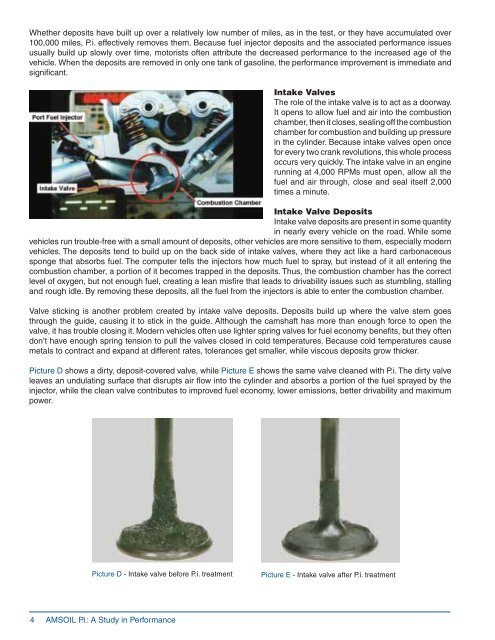AMSOIL P.i. - A Study in Performance (G2543) - Synthetic Motor Oil
AMSOIL P.i. - A Study in Performance (G2543) - Synthetic Motor Oil
AMSOIL P.i. - A Study in Performance (G2543) - Synthetic Motor Oil
Create successful ePaper yourself
Turn your PDF publications into a flip-book with our unique Google optimized e-Paper software.
Whether deposits have built up over a relatively low number of miles, as <strong>in</strong> the test, or they have accumulated over<br />
100,000 miles, P.i. effectively removes them. Because fuel <strong>in</strong>jector deposits and the associated performance issues<br />
usually build up slowly over time, motorists often attribute the decreased performance to the <strong>in</strong>creased age of the<br />
vehicle. When the deposits are removed <strong>in</strong> only one tank of gasol<strong>in</strong>e, the performance improvement is immediate and<br />
significant.<br />
Intake Valves<br />
The role of the <strong>in</strong>take valve is to act as a doorway.<br />
It opens to allow fuel and air <strong>in</strong>to the combustion<br />
chamber, then it closes, seal<strong>in</strong>g off the combustion<br />
chamber for combustion and build<strong>in</strong>g up pressure<br />
<strong>in</strong> the cyl<strong>in</strong>der. Because <strong>in</strong>take valves open once<br />
for every two crank revolutions, this whole process<br />
occurs very quickly. The <strong>in</strong>take valve <strong>in</strong> an eng<strong>in</strong>e<br />
runn<strong>in</strong>g at 4,000 RPMs must open, allow all the<br />
fuel and air through, close and seal itself 2,000<br />
times a m<strong>in</strong>ute.<br />
Intake Valve Deposits<br />
Intake valve deposits are present <strong>in</strong> some quantity<br />
<strong>in</strong> nearly every vehicle on the road. While some<br />
vehicles run trouble-free with a small amount of deposits, other vehicles are more sensitive to them, especially modern<br />
vehicles. The deposits tend to build up on the back side of <strong>in</strong>take valves, where they act like a hard carbonaceous<br />
sponge that absorbs fuel. The computer tells the <strong>in</strong>jectors how much fuel to spray, but <strong>in</strong>stead of it all enter<strong>in</strong>g the<br />
combustion chamber, a portion of it becomes trapped <strong>in</strong> the deposits. Thus, the combustion chamber has the correct<br />
level of oxygen, but not enough fuel, creat<strong>in</strong>g a lean misfire that leads to drivability issues such as stumbl<strong>in</strong>g, stall<strong>in</strong>g<br />
and rough idle. By remov<strong>in</strong>g these deposits, all the fuel from the <strong>in</strong>jectors is able to enter the combustion chamber.<br />
Valve stick<strong>in</strong>g is another problem created by <strong>in</strong>take valve deposits. Deposits build up where the valve stem goes<br />
through the guide, caus<strong>in</strong>g it to stick <strong>in</strong> the guide. Although the camshaft has more than enough force to open the<br />
valve, it has trouble clos<strong>in</strong>g it. Modern vehicles often use lighter spr<strong>in</strong>g valves for fuel economy benefits, but they often<br />
don’t have enough spr<strong>in</strong>g tension to pull the valves closed <strong>in</strong> cold temperatures. Because cold temperatures cause<br />
metals to contract and expand at different rates, tolerances get smaller, while viscous deposits grow thicker.<br />
Picture D shows a dirty, deposit-covered valve, while Picture E shows the same valve cleaned with P.i. The dirty valve<br />
leaves an undulat<strong>in</strong>g surface that disrupts air flow <strong>in</strong>to the cyl<strong>in</strong>der and absorbs a portion of the fuel sprayed by the<br />
<strong>in</strong>jector, while the clean valve contributes to improved fuel economy, lower emissions, better drivability and maximum<br />
power.<br />
Picture D - Intake valve before P.i. treatment<br />
Picture E - Intake valve after P.i. treatment<br />
4 <strong>AMSOIL</strong> P.i.: A <strong>Study</strong> <strong>in</strong> <strong>Performance</strong>




